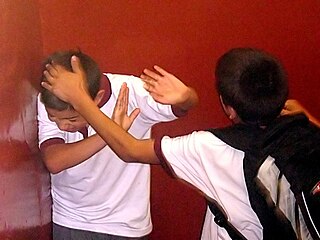
Bullying is the use of force, coercion, hurtful teasing or threat, to abuse, aggressively dominate or intimidate. The behavior is often repeated and habitual. One essential prerequisite is the perception of an imbalance of physical or social power. This imbalance distinguishes bullying from conflict. Bullying is a subcategory of aggressive behavior characterized by hostile intent, imbalance of power and repetition over a period of time.
School violence includes violence between school students as well as attacks by students on school staff and attacks by school staff on students. It encompasses physical violence, including student-on-student fighting, corporal punishment; psychological violence such as verbal abuse, and sexual violence, including rape and sexual harassment. It includes many forms of bullying and carrying weapons to school. The one or more perpetrators typically have more physical, social, and/or psychological power than the victim. It is a widely accepted serious societal problem in recent decades in many countries, especially where weapons such as guns or knives are involved.

School bullying, like bullying outside the school context, refers to one or more perpetrators who have greater physical strength or more social power than their victim and who repeatedly act aggressively toward their victim. Bullying can be verbal or physical. Bullying, with its ongoing character, is distinct from one-off types of peer conflict. Different types of school bullying include ongoing physical, emotional, and/or verbal aggression. Cyberbullying and sexual bullying are also types of bullying. Bullying even exists in higher education. There are warning signs that suggest that a child is being bullied, a child is acting as a bully, or a child has witnessed bullying at school.

Pink Shirt Day is an annual event against bullying, held in Canada and New Zealand. Participants wear pink shirts and attend or host informative events to raise awareness about bullying, particularly in schools. Pink Shirt Day was started in 2007 in Canada, where it is held on the last Wednesday of February each year. It was adopted in New Zealand in 2009 and is observed annually on the third Friday of May.
Mobile harassment refers to the act of sending any type of text message, sex photo message, video message, or voicemail from a mobile phone that causes the receiver to feel harassed, threatened, tormented, humiliated, embarrassed or otherwise victimized. It is recognized as a form of cyberbullying.
Researchers study Social media and suicide to find if a correlation exists between the two. Some research has shown that there may be a correlation.

Sexual bullying is a form of bullying or harassment in connection with a person's sex, body, sexual orientation or with sexual activity. It can be physical, verbal or emotional in nature, and occurs in various settings, including schools, workplaces, and online platforms. Sexual bullying can have serious and lasting effects on the mental and emotional well-being of victims.
Bullying suicide are considered together when the cause of suicide is attributable to the victim having been bullied, either in person or via social media. Writers Neil Marr and Tim Field wrote about it in their 2001 book Bullycide: Death at Playtime.
Helen Cowie FBPS, PGCE, is Emeritus Professor in the Health and Social Care division of the Faculty of Health and Medical Sciences at the University of Surrey.
Anti-bullying legislation is a legislation enacted to help reduce and eliminate bullying. This legislation may be national or sub-national and is commonly aimed at ending bullying in schools or workplaces.
Cyberbullying is a form of bullying or harassment using electronic means. It has become increasingly common, especially among teenagers and adolescents, due to young people's increased use of social media. Related issues include online harassment and trolling. In 2015, according to cyberbullying statistics from the i–Safe Foundation, over half of adolescents and teens had been bullied online, and about the same number had engaged in cyberbullying. Both the bully and the victim are negatively affected, and the intensity, duration, and frequency of bullying are three aspects that increase the negative effects on both of them.

James O'Higgins Norman PC, MStJ, FRSA holds the UNESCO Chair on Tackling Bullying in Schools and Cyberspace at Dublin City University. He is the director of the National Anti-Bullying Research and Resource Centre, and a member of the Government of Ireland Advisory Council on Online Safety.
Dorothy Espelage is an American psychologist. She is the William C. Friday Distinguished Professor of Education at the University of North Carolina, and an international expert in bullying, youth aggression, and teen dating violence. She has authored several books including Bullying in North American Schools, Bullying Prevention and Intervention: Realistic Strategies for Schools, and Handbook of Bullying in Schools: an International Perspective.
Bullying in higher education refers to the bullying of students as well as faculty and staff taking place at institutions of higher education such as colleges and universities. It is believed to be common although it has not received as much attention from researchers as bullying in some other contexts. This article focuses on bullying of students; see Bullying in academia regarding faculty and staff.
School-related gender-based violence (SRGBV) can be defined as acts or threats of sexual, physical or psychological violence happening in and around schools. This type of violence is due to gender norms and stereotypes. It can include verbal abuse, bullying, sexual abuse, harassment and other types of violence. SRGBV is widely spread around the world and is common in many societies. Millions of children and families suffer from this type of violence. Incidents related to SRGBV has been reported in all countries and regions of the world.
Christina Salmivalli is a Finnish professor of psychology and the deputy head of the INVEST research flagship at the University of Turku in Finland. Salmivalli is recognized as an expert on peer relations and school bullying.
School violence prevention through education is the attempt to reduce violence and bullying through comprehensive approaches and interventions within the education sector. It aims to create a safe and non-violent learning environment. Acceptable practices include strong leadership; a safe and inclusive school environment; developing knowledge, attitudes, and skills; effective partnerships; implementing mechanisms for reporting and providing appropriate support and services, and collecting and using evidence.
World Days or International Days observed at UNESCO designated by United Nations General Assembly for marking and commemorating "important aspects of human life and history".
Sameer Hinduja is an American social scientist. He serves as Professor of Criminology at Florida Atlantic University and co-director of the Cyberbullying Research Center. He has served as a Fulbright Specialist Scholar at Dublin City University and currently serves as Faculty Associate at the Berkman Klein Center at Harvard University. Hinduja is also the co-founder and Co-Editor-in-Chief of the International Journal of Bullying Prevention. He is an international expert in cyberbullying, sexting, sextortion, online and offline dating violence, digital self-harm, and related forms of online harm among youth. He has written eight books, including Bullying Today: Bullet Points and Best Practices, Bullying Beyond the Schoolyard: Preventing and Responding to Cyberbullying, and School Climate 2.0. His research publications have been cited approximately 23,000 times, and have appeared in such outlets as Journal of Adolescent Health, Journal of Youth and Adolescence, Journal of Interpersonal Violence, Computers in Human Behavior, and New Media and Society. Topics studied include empathy, psychological resilience, parenting, social and emotional learning, school climate, and well-being.
Bullying of lesbian, gay, bisexual, or transgender (LGBT) people, particularly LGBT youth, involves intentional actions toward the victim, repeated negative actions by one or more people against another person, and an imbalance of physical or psychological power.




